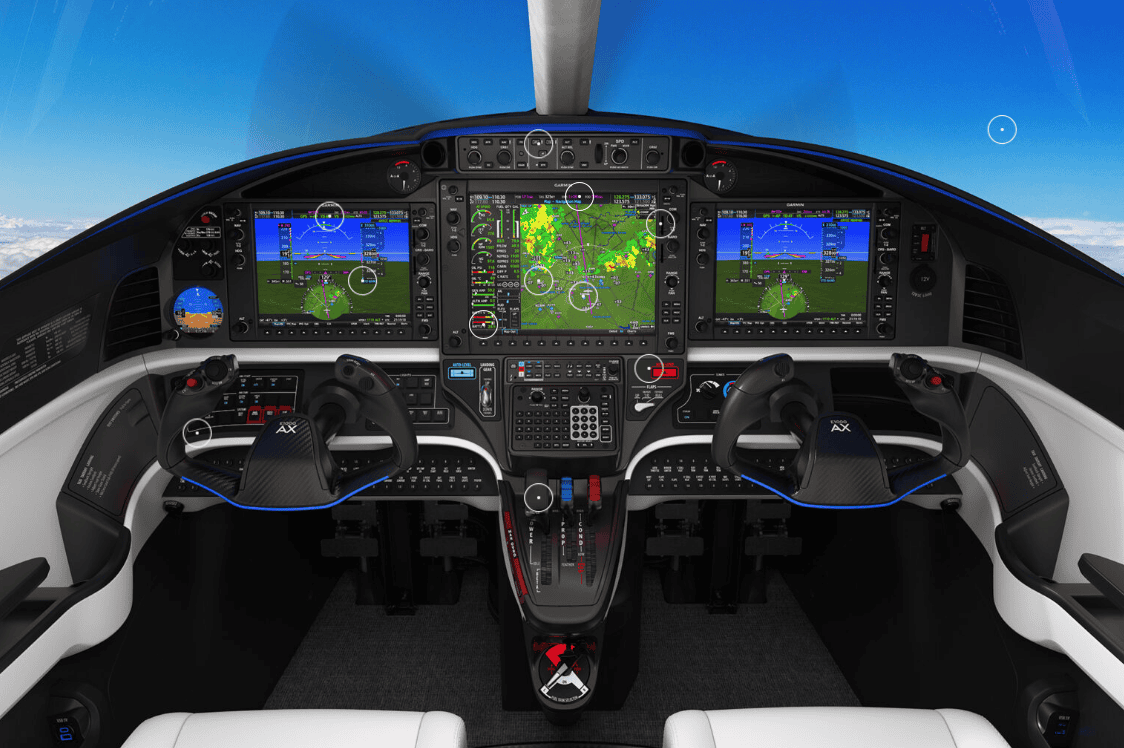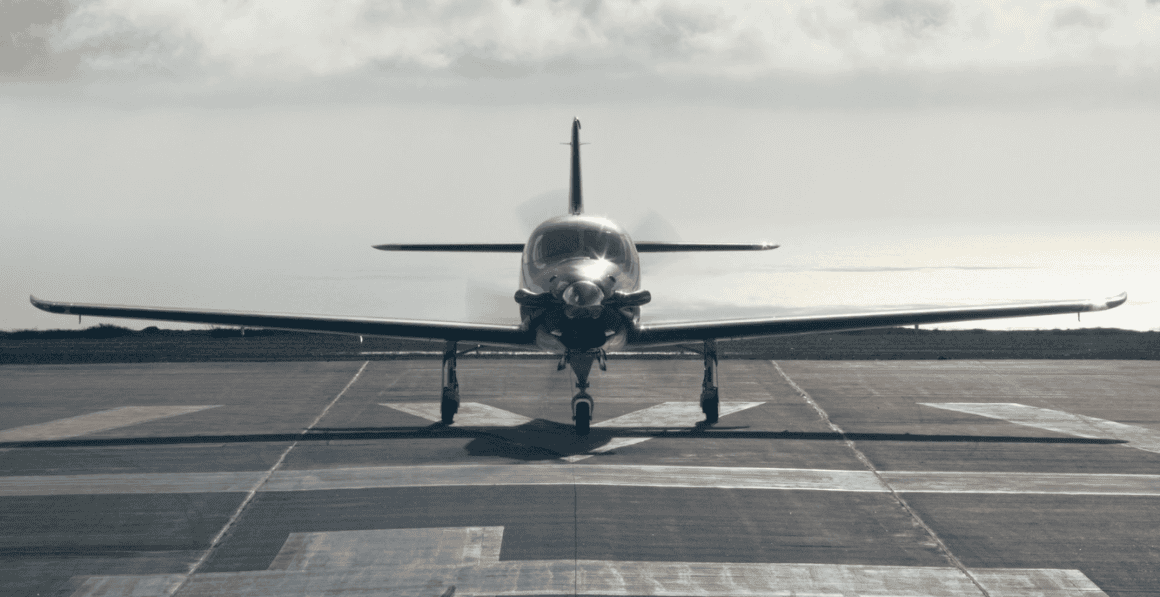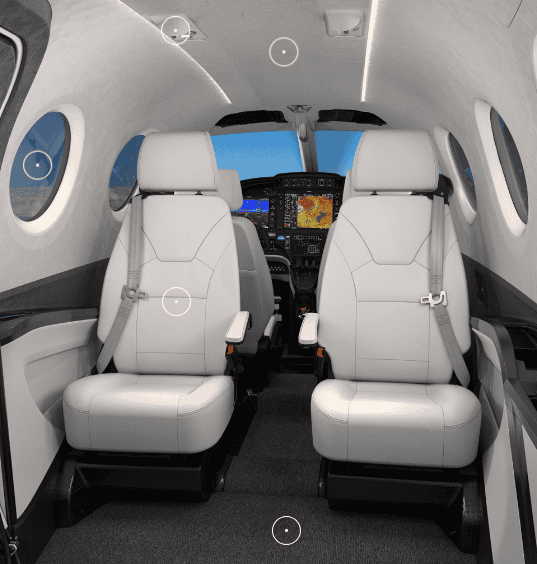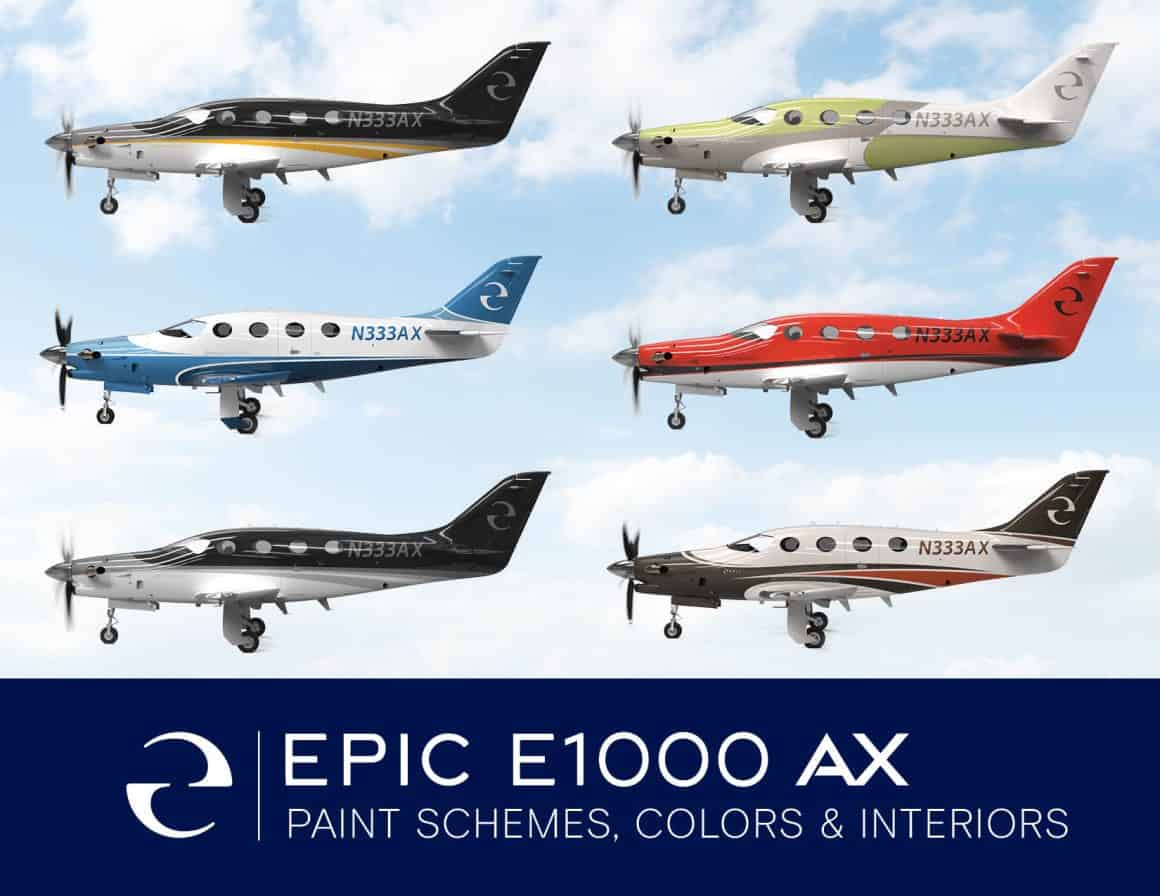When you think of high-performance, single-engine aircraft, Cirrus often comes to mind. Models like the SR22T or Vision Jet have long set the standard for personal and business aviation. But this past April, at Sun ‘n Fun in Lakeland, Fla., Epic Aircraft rolled out the Epic E1000 AX, and boy, does it have people talking.
This turbine-powered aircraft features a sleek carbon fiber design, advanced avionics, and a suite of 25 new features. Based on the standout features alone, the E1000 AX is positioning itself as a potential challenger to Cirrus’s dominance in the market.
So, is the Epic E1000 AX really a serious contender? We examine that question in this story.
Performance to Impress

The Epic E1000 AX is powered by a Pratt & Whitney PT6-67A engine, delivering an impressive 1,200 horsepower. It boasts a max cruise speed of 333 KTAS, a climb rate of 4,000 feet per minute, and a max ceiling of 34,000 feet. Flying cross-country with the E1000 AX is no problem, as it boasts a range of 1,560 nautical miles when fully loaded with 1,177 pounds of passengers and luggage. Compared to the previous E1000 model (the GX), it offers 50 additional pounds for payload, with a useful load of 2,956 pounds and a fuel capacity of 264 gallons.
Its takeoff distance is 2,254 feet, landing distance is 2,399 feet, and stall speed is a forgiving 68 KIAS. The aircraft measures 35 feet 10 inches long, 12 feet 6 inches tall, and has a 43-foot wingspan. Its 15-foot cabin comfortably seats six passengers. The cockpit also can accommodate pilots up to 6’8″ tall, which this 6’1″ author certainly appreciates.
One of the standout features of the E1000 AX is its carbon fiber construction. Unlike traditional metal aircraft, it uses fewer parts, streamlining production and reducing operating costs. This design will likely give Epic a pricing edge, with AOPA reporting that the starting price for the E1000 AX will start at $4.7 million and go up to $4.85 million with customization. By comparison, a brand-new Cirrus SF50 Vision Jet has a base price of about $3 million.
Cirrus, which also uses composite designs, keeps costs competitive. However, the E1000 AX’s approach could appeal to buyers looking for efficiency without sacrificing strength.
Avionics and Safety: A Step Ahead?

The Epic E1000 AX comes equipped with the Garmin G1000 NXi avionics suite, featuring synthetic vision, GPS, traffic, weather, terrain, and engine monitoring systems. Among its 25 new features are the Garmin Autothrottle and Autoland.
Autothrottle manages engine power from takeoff to landing, adjusting for optimal settings and protecting it against issues like throttle rollback, overtorque, or overtemperature. It even responds to overspeed, underspeed, or engine failure scenarios, factoring in flap and gear positions. These auto responses could reduce pilot workload, especially on long flights, but it’s worth noting that Cirrus’s Perspective+ avionics also offers advanced automation.
Now, Garmin Autoland is where things get intriguing. If a pilot becomes incapacitated, passengers can activate it with the press of a button. It can also engage automatically if no one acts. Autoland selects the best airport for landing based on runway length, fuel range, distance, and weather, then navigates around obstacles, communicates with air traffic control, lands the plane, and shuts down the engine.

Autoland is absolutely an incredible safety feature, but how does it compare to Cirrus’s CAPS (Cirrus Airframe Parachute System) feature? CAPS is proven and simple: deploying a parachute to lower the entire aircraft to the ground in an emergency. Autoland, while innovative, relies on complex automation and a suitable runway, which might not always be available in remote areas. Both systems aim to save lives, but they cater to different scenarios.
Other features of the Epic E1000 AX include:
- Automatic Yaw Damper: Engages post-takeoff and pre-landing for smoother rudder coordination.
- Electronic Brake Hold: Prevents movement on the ground and simplifies operations.
- CoolView Windows: This technology blocks over 73% of infrared heat and UV rays, improving comfort and visibility for both the flight crew and the passengers.
- GDL 60 Datalink with PlaneSync Technology: Automates database updates and enables remote aircraft monitoring.
- GRA 5500 Radar Altimeter: Enhances above-ground-level awareness.
- 3D SafeTaxi & Taxiway Routing: Improves ground navigation.
- GWX 8000 StormOptix Weather Radar: Provides real-time thunderstorm data.
- True Blue Power Lithium-Ion Batteries: Offer long life and lower maintenance. Also reduces overall aircraft weight.

There’s no doubt that these features make the E1000 AX a tech-forward aircraft. (I am definitely aging myself here, but I remember being a student at Embry-Riddle, and GPS navigation was introduced to our ancient Tampico trainers. We 100% thought the future had arrived. Little did we know how incredible 2025 technology would be. Anyway, I digress.) While Epic’s tech is impressive, Cirrus avionics are nothing to sneeze at. Features like Envelope Protection and integrated weather systems stand out with Cirrus.
The question is whether Epic’s tech feels like a leap forward or just a different flavor of advanced.
Comfort and Practicality in the Cabin

The Epic E1000 AX offers a spacious 15-foot cabin and an expansive windscreen with CoolView windows, which enhance visibility and keep the interior comfortable by blocking heat and UV rays. With a full fuel payload of 1,150 pounds and a useful load of 2,956 pounds, it’s practical for carrying passengers and luggage on long trips. The inclusion of Starlink Internet is undoubtedly a selling point. Despite becoming more common, staying connected at altitude still feels like a luxury.
Cirrus has long been known for its plush, car-like interiors, and pilot-friendly cockpits, and the E1000 AX seems to aim for a similar vibe. Its carbon fiber build and efficient batteries could lower maintenance costs. Still, without public pricing data at this point in time, it’s hard to say how it compares to Cirrus’s operating expenses. Both aircraft prioritize comfort, but Epic’s taller cockpit clearance and internet connectivity might sway pilots who value those extras.

Epic is Emerging as a Strong Player in the General Aviation Market

Bend, Oregon-based Epic Aircraft, founded in 2004 under CEO Doug King, has been steadily climbing the aviation ladder. It started with the experimental Epic LT in 2004, followed by the E1000 in 2019 and the FAA-certified E1000 GX in 2021. The Epic E1000AX, now in its final certification stages (it should be certified any day now), builds on that legacy. Epic is hedging its bets on this model to compete with industry leaders like Cirrus, Cessna, Honda, Piper, Pilatus, Beechcraft, and others.

To showcase the E1000 AX, Epic is hosting a demo tour this summer. While some stops have already taken place, additional stops yet to take place include:
- Southern California | Jul 7-11
- Camarillo, CA (CMA) | Jul 7
- Van Nuys, CA (VNY) | Jul 8
- Long Beach, CA (LGB) | Jul 9
- San Diego, CA (MYF) | Jul 11
- Oshkosh, WI (OSH) | EAA AirVenture | Jul 21-27
- Wisconsin & Illinois | Jul 29-31
- Palo Alto, CA (PAO) | US Aircraft Expo | Aug 8-9
- Northern California | Aug 11-15
- Northeast Region (CT, MA, VT, ME, NH, RI, VT) | Aug 26-28
- Tri-State Region (NY, NJ, PA) | Sep 2-5
- San Diego, CA (CRQ) | US Aircraft Expo | Oct 10-11
- Scottsdale, AZ (SDL) | US Aircraft Expo | Nov 7-8
Interested pilots and potential buyers can RSVP for the demo here.
Can the E1000 AX Really Challenge Cirrus?

So, does the Epic E1000 AX have what it takes to rival Cirrus? We think Cirrus loyalists will be interested in the E1000 AX because it matches or surpasses Cirrus in several key areas, including faster cruise speed, higher climb rate, and comparable range. Its carbon fiber design could offer cost advantages.
The avionics suite is state-of-the-art with Autothrottle and Autoland, though Cirrus’s proven systems and CAPS parachute remain a high bar. The E1000 AX’s spacious cabin, internet connectivity, and pilot-friendly features make it appealing. While the price tag for the E1000 AX will reportedly begin at $4.5 million, it’s hard to gauge its true value proposition without knowing actual operating costs.
Cirrus has built a loyal following with its performance, safety, and luxury blend, but the E1000 AX brings a fresh perspective. Its autonomous landing system is a futuristic feature for sure, though it’s untested in real-world emergencies compared to CAPS (Cirrus Airframe Parachute System). Epic’s focus on efficiency and modern technology could attract buyers, but Cirrus’s established reputation and dealer network are tough to beat. The Epic E1000 AX is a worthy alternative, but whether it can truly challenge Cirrus depends on how it performs in the hands of pilots and how Epic positions it in the market.
For now, we will keep an eye on the final certification process. And for those of you in any of the regions of the country featured on the demo tour, we would say it’s definitely worth a closer look––and maybe even a test flight.
